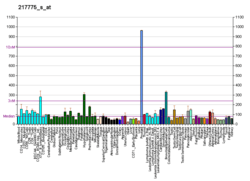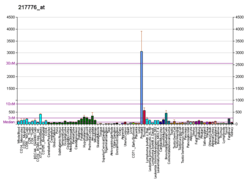RDH11
Retinol dehydrogenase 11 is an enzyme that in humans is encoded by the RDH11 gene.[5][6][7][8]
RHD11, a member of the short-chain dehydrogenase/reductase (SDR) superfamily of oxidoreductases, is expressed at high levels in prostate epithelium, and its expression is regulated by androgens.[supplied by OMIM][8]
Clinical significance
Mutations in RDH11 are associated to retinitis pigmentosa .[9]
References
- 1 2 3 GRCh38: Ensembl release 89: ENSG00000072042 - Ensembl, May 2017
- 1 2 3 GRCm38: Ensembl release 89: ENSMUSG00000066441 - Ensembl, May 2017
- ↑ "Human PubMed Reference:".
- ↑ "Mouse PubMed Reference:".
- ↑ Haeseleer F, Jang GF, Imanishi Y, Driessen CA, Matsumura M, Nelson PS, Palczewski K (Nov 2002). "Dual-substrate Specificity Short Chain Retinol Dehydrogenases from the Vertebrate Retina". J Biol Chem. 277 (47): 45537–46. doi:10.1074/jbc.M208882200. PMC 1435693. PMID 12226107.
- ↑ Hara T, Harada N, Mitsui H, Miura T, Ishizaka T, Miyajima A (Aug 1994). "Characterization of cell phenotype by a novel cDNA library subtraction system: expression of CD8 alpha in a mast cell-derived interleukin-4-dependent cell line". Blood. 84 (1): 189–99. PMID 8018917.
- ↑ Persson B, Kallberg Y, Bray JE, Bruford E, Dellaporta SL, Favia AD, Duarte RG, Jornvall H, Kavanagh KL, Kedishvili N, Kisiela M, Maser E, Mindnich R, Orchard S, Penning TM, Thornton JM, Adamski J, Oppermann U (Feb 2009). "The SDR (Short-Chain Dehydrogenase/Reductase and Related Enzymes) Nomenclature Initiative". Chem Biol Interact. 178 (1–3): 94–8. doi:10.1016/j.cbi.2008.10.040. PMC 2896744. PMID 19027726.
- 1 2 "Entrez Gene: RDH11 retinol dehydrogenase 11 (all-trans/9-cis/11-cis)".
- ↑ Xie, Y. A.; Lee, W; Cai, C; Gambin, T; Nõupuu, K; Sujirakul, T; Ayuso, C; Jhangiani, S; Muzny, D; Boerwinkle, E; Gibbs, R; Greenstein, V. C.; Lupski, J. R.; Tsang, S. H.; Allikmets, R (2014). "New syndrome with retinitis pigmentosa is caused by nonsense mutations in retinol dehydrogenase RDH11". Human Molecular Genetics. 23: 5774–5780. doi:10.1093/hmg/ddu291. PMC 4189905. PMID 24916380.
Further reading
- Lai CH, Chou CY, Ch'ang LY, et al. (2000). "Identification of Novel Human Genes Evolutionarily Conserved in Caenorhabditis elegans by Comparative Proteomics". Genome Res. 10 (5): 703–13. doi:10.1101/gr.10.5.703. PMC 310876. PMID 10810093.
- Lin B, White JT, Ferguson C, et al. (2001). "Prostate short-chain dehydrogenase reductase 1 (PSDR1): a new member of the short-chain steroid dehydrogenase/reductase family highly expressed in normal and neoplastic prostate epithelium". Cancer Res. 61 (4): 1611–8. PMID 11245473.
- Kedishvili NY, Chumakova OV, Chetyrkin SV, et al. (2002). "Evidence that the human gene for prostate short-chain dehydrogenase/reductase (PSDR1) encodes a novel retinal reductase (RalR1)". J. Biol. Chem. 277 (32): 28909–15. doi:10.1074/jbc.M202588200. PMID 12036956.
- Strausberg RL, Feingold EA, Grouse LH, et al. (2003). "Generation and initial analysis of more than 15,000 full-length human and mouse cDNA sequences". Proc. Natl. Acad. Sci. U.S.A. 99 (26): 16899–903. doi:10.1073/pnas.242603899. PMC 139241. PMID 12477932.
- Li K, Wang L, Cheng J, et al. (2003). "Interaction between hepatitis C virus core protein and translin protein--a possible molecular mechanism for hepatocellular carcinoma and lymphoma caused by hepatitis C virus". World J. Gastroenterol. 9 (2): 300–3. doi:10.3748/wjg.v9.i2.300. PMID 12532453.
- Belyaeva OV, Stetsenko AV, Nelson P, Kedishvili NY (2004). "Properties of short-chain dehydrogenase/reductase RalR1: characterization of purified enzyme, its orientation in the microsomal membrane, and distribution in human tissues and cell lines". Biochemistry. 42 (50): 14838–45. doi:10.1021/bi035288u. PMID 14674758.
- Ota T, Suzuki Y, Nishikawa T, et al. (2004). "Complete sequencing and characterization of 21,243 full-length human cDNAs". Nat. Genet. 36 (1): 40–5. doi:10.1038/ng1285. PMID 14702039.
- Gerhard DS, Wagner L, Feingold EA, et al. (2004). "The Status, Quality, and Expansion of the NIH Full-Length cDNA Project: The Mammalian Gene Collection (MGC)". Genome Res. 14 (10B): 2121–7. doi:10.1101/gr.2596504. PMC 528928. PMID 15489334.
- Otsuki T, Ota T, Nishikawa T, et al. (2007). "Signal sequence and keyword trap in silico for selection of full-length human cDNAs encoding secretion or membrane proteins from oligo-capped cDNA libraries". DNA Res. 12 (2): 117–26. doi:10.1093/dnares/12.2.117. PMID 16303743.
- Kasus-Jacobi A, Birch DG, Anderson RE (2007). "Photoreceptor retinol dehydrogenases. An attempt to characterize the function of Rdh11". Adv. Exp. Med. Biol. Advances in Experimental Medicine and Biology. 572: 505–11. doi:10.1007/0-387-32442-9_70. ISBN 978-0-387-28464-4. PMID 17249616.
- Roni V, Carpio R, Wissinger B (2007). "Mapping of transcription start sites of human retina expressed genes". BMC Genomics. 8: 42. doi:10.1186/1471-2164-8-42. PMC 1802077. PMID 17286855.
This article is issued from
Wikipedia.
The text is licensed under Creative Commons - Attribution - Sharealike.
Additional terms may apply for the media files.





